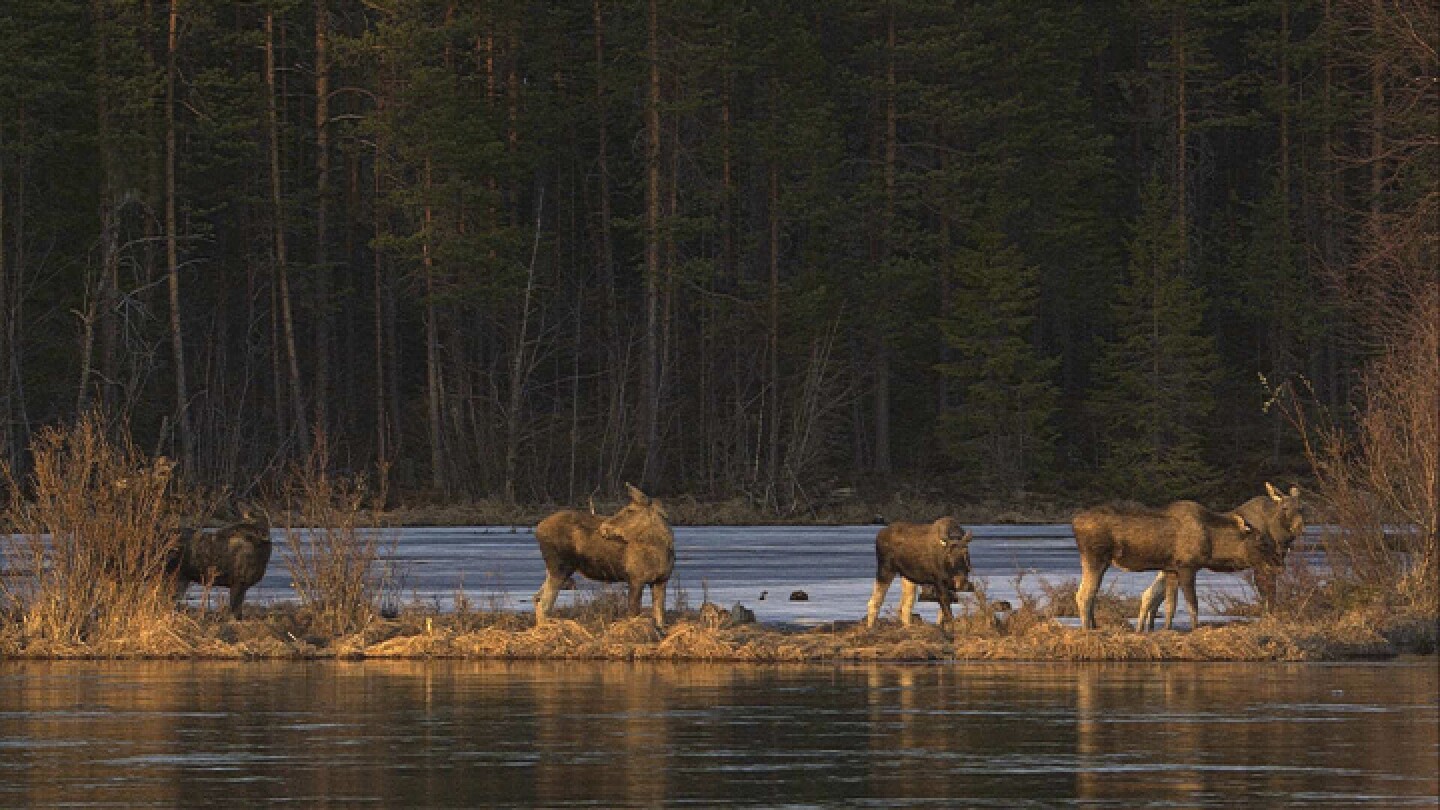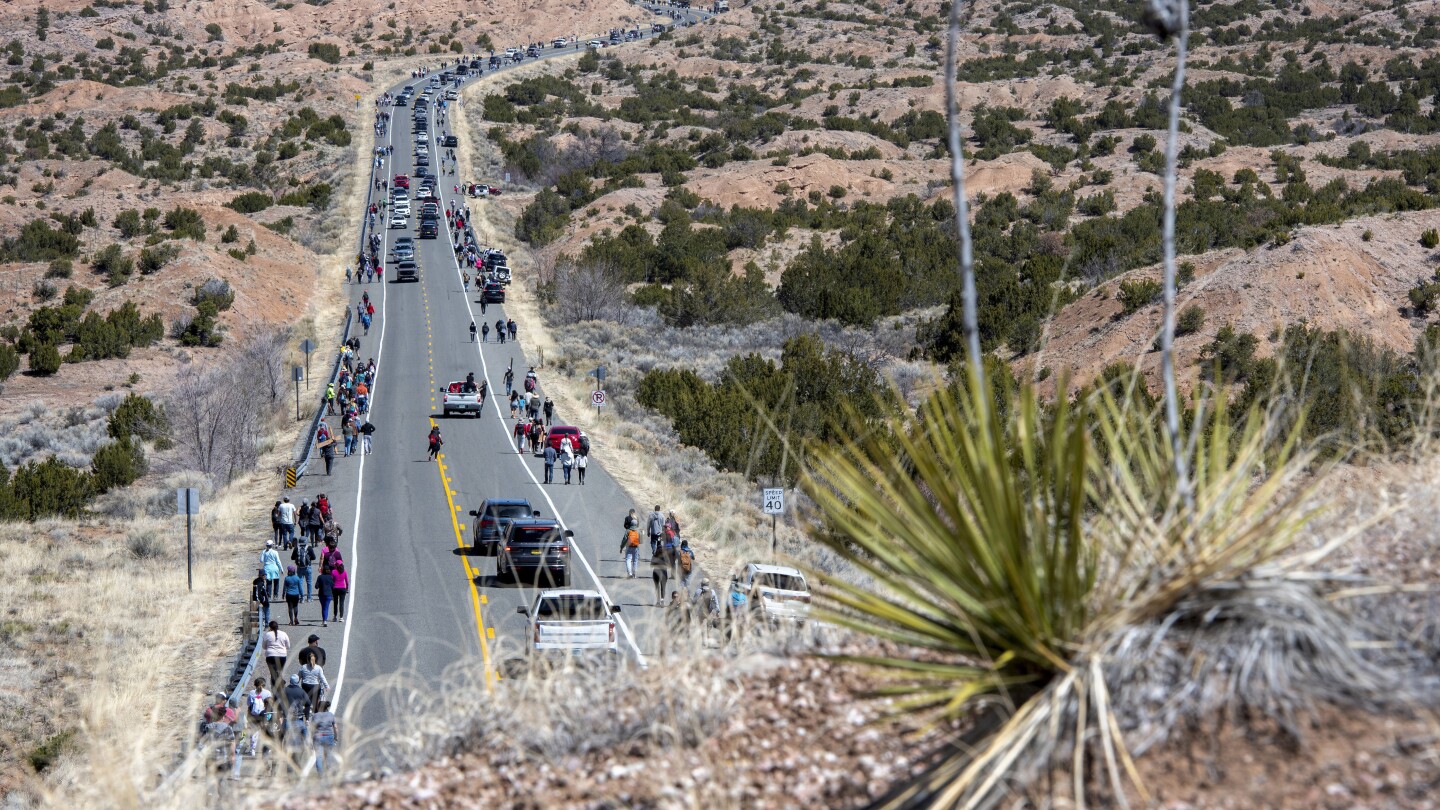Lifestyle
Livestream of moose migrating to their summer pastures fascinates millions

Before Swedish slow TV hit “The Great Moose Migration” began airing Tuesday, Ulla Malmgren stocked up on coffee and prepared meals so she doesn’t miss a moment of the 20-day, 24-hour event.
“Sleep? Forget it. I don’t sleep,” she said.
Malmgren, 62, isn’t alone. The show, called “ Den stora älgvandringen ” in Swedish, and sometimes translated as “The Great Elk Trek” in English, began in 2019 with nearly a million people watching. In 2024, the production hit 9 million viewers on SVT Play, the streaming platform for national broadcaster SVT.
The livestream kicked off a week ahead of schedule due to warm weather and early moose movement. Malmgren was ready.
This undated photo, issued by SVT, shows Moose in Junsele, Sweden during preparations for the livestream ‘The Great Moose Migration’ to document the annual Moose migration near Kullberg in northern Sweden. (SVT via AP)
From now until May 4, the livestream’s remote cameras will capture dozens of moose as they swim across the Ångerman River, some 300 kilometers (187 miles) northwest of Stockholm, in the annual spring migration toward summer grazing pastures.
Not much happens for hours at a time, and fans say that’s the beauty of it.
“I feel relaxed, but at the same time I’m like, ‘Oh, there’s a moose. Oh, what if there’s a moose? I can’t go to the toilet!’” said William Garp Liljefors, 20, who has collected more than 150 moose plush toys since 2020.
Slow TV success
“The Great Moose Migration” is part of a trend that began in 2009 with Norwegian public broadcaster NRK’s minute-by-minute airing of a seven-hour train trip across the southern part of the country.
The slow TV style of programming has spread, with productions in the United Kingdom, China and elsewhere. The central Dutch city of Utrecht, for example, installed a “ fish doorbell ” on a river lock that lets livestream viewers alert authorities to fish being held up as they migrate to spawning grounds.
Annette Hill, a professor of media and communications at Jönköping University in Sweden, said slow TV has roots in reality television but lacks the staging and therefore feels more authentic for viewers. The productions allow the audience to relax and watch the journey unfold.
“It became, in a strange way, gripping because nothing catastrophic is happening, nothing spectacular is happening,” she said. “But something very beautiful is happening in that minute-by-minute moment.”
As an expert and a fan of “The Great Moose Migration,” Hill said the livestream helps her slow down her day by following the natural rhythms of spring.
“This is definitely a moment to have a calm, atmospheric setting in my own home, and I really appreciate it,” she said.
Nature in your living room
The calming effect extends to the crew, according to Johan Erhag, SVT’s project manager for “The Great Moose Migration.”
“Everyone who works with it goes down in their normal stress,” he said.
The moose have walked the route for thousands of years, making it easy for the crew to know where to lay some 20,000 meters (almost 12 miles) of cable and position 26 remote cameras and seven night cameras. A drone is also used.
The crew of up to 15 people works out of SVT’s control room in Umeå, producing the show at a distance to avoid interfering with the migration.
SVT won’t say how much the production costs, but Erhag said it’s cheap when accounting for the 506 hours of footage aired last year.
This undated photo, issued by SVT, shows preparations in Junsele, Sweden for the livestream ‘The Great Moose Migration’ to document the annual Moose migration near Kullberg in northern Sweden. (SVT via AP)
Erhag said Swedes have always been fascinated by the roughly 300,000 moose roaming in their woods. The Scandinavian country’s largest animal is known as “King of the Forest.” A bull moose can reach 210 centimeters (6 feet 10 inches) at shoulder height and weigh 450 kilograms (992 pounds).
Despite their size, the herbivores are typically shy and solitary.
“We actually don’t see it very often. You often see it when you’re out driving maybe once or twice in your life,” Erhag said. “I think that’s one thing why it has been so, so popular. And then you bring in the nature to everyone’s living room.”
Hanna Sandberg, 36, first began watching the show in 2019, though she didn’t spot any moose. She tuned in the following year, finally saw some and got hooked.
“You can watch them and be a part of their natural habitat in a way that you could never be otherwise,” she said.
Moose mega-fans
After hours of showing an empty forest, a camera captures footage of a moose approaching the riverbank. Suddenly, slow TV turns urgent.
The push alert hits SVT’s app — “Första älgarna i bild!” which translates to “First moose on camera!” — as viewers worldwide tune in. The livestream’s chat explodes as commenters type encouragement for the animal, now making its way into the water.
”I would actually like to be a little fly on the wall in every household that watches the moose migration. Because I think there is about a million people saying about the same thing: ‘Go on! Yes, you can do it!’” Malmgren said.
Mega-fans like Malmgren, who is in a Facebook group of 76,000-plus viewers, are committed to watching as many hours as possible.
“I was late to school because I saw moose and my teacher was like, ‘What, you saw moose in the city?’ And I was like, ‘No, it’s on the TV,’” Garp Liljefors said.
Malmgren said friends and family have learned not to bother her when the moose are on the move.
“When someone asks me, ‘What are you doing? Oh, never mind, it’s the great migration,’” she said. “They know.”
Lifestyle
Look inside Maine’s ‘Sistine Chapel’ with 70-year-old frescoes

SOLON, Maine (AP) — From the outside, it looks like any other New England church building: a boxy, white structure with a single steeple surrounded by an old stone wall, set against rolling hills and pine forest.
Inside, though, the South Solon Meeting House has a secret unknown even to some who drive through the tiny Maine town every day. The interior of the building is covered in 70-year-old fresco murals that encourage some in the state’s art community to describe it as “Maine’s Sistine Chapel.”
The murals were painted by artists in the 1950s and, while they have long been appreciated by visitors, the recent creation of a website dedicated to them by students at Colby College in Waterville, Maine, has generated new interest in the paintings.
Véronique Plesch, a Colby professor of art, hopes the building inspires more appreciation of frescoes.
“I fell in love with the place, because I have studies frescoes all my life,” said Plesch, who is a member of the board of the historical society that cares for the meeting house. She added that the paintings should stay in public places and not be in private institutions.
The meeting house was built in 1842 and hosted church services until the 1940s, though there were periods of closure, such as times of war. A decade later, Margaret Day Blake found the building in a state of disuse and the former student at the nearby Skowhegan School of Painting and Sculpture put out a call for young artists to paint frescoes under the school’s supervision in 1951.
The artists were given creative freedom and told there would be no limits to subject matter, but that Biblical scenes would “offer rich and suitable” imagery. The interior was covered in such scenes from 1952 to 1956 and the walls remain adorned with frescoes, including one that references Leonardo da Vinci’s “The Last Supper.”
Another fresco depicts the binding of Isaac, in which a hooded Abraham prepares to sacrifice his son on God’s orders. The Great Flood is depicted as it was by Michelangelo at the Sistine Chapel at the Vatican.
Two of the 13 artists — Sigmund Abeles of New York City and Sidney Hurwitz of Newton, Massachusetts — both in their 90s, are still living. Both spoke fondly about their time at the meeting house.
“We would go out there and paint and then take a lunch break in the cemetery behind the building. It was a very idyllic time,” Hurwitz said. “I very much enjoyed it.”
Today, the meeting house, which is open to the public without locks on its doors, serves as a community gathering and performance space. Many of its old features, including box pews made for smaller people of a different time, are still intact.
Abeles recalled painting the scene of Jacob wrestling with the angel from the Book of Genesis.
“It’s a very, very special place, and it was a unique experience” to work on the frescoes, Abeles said.
On a recent Sunday morning, Plesch gave a lecture at the meeting house before a group of members of the Maine Art Education Association as part of the group’s spring conference. Long ago, attendants of the building might have been preparing for an Easter service, but on this day it was full of teachers fascinated by the frescoes.
Suzanne Goulet, an art teacher at a nearby high school, said she was previously aware of the frescoes and confessed she had peaked into the windows of the old building, adding that it’s great the paintings are still inspiring art lovers decades later.
“The inspiration is that we bring it back to our students,” Goulet said.
Lifestyle
Thousands of pilgrims trek through New Mexico desert to historic adobe church for Good Friday

SANTA FE, N.M. (AP) — A unique Holy Week tradition is drawing thousands of Catholic pilgrims to a small adobe church in the hills of northern New Mexico, in a journey on foot through desert badlands to reach a spiritual wellspring.
For generations, people of the Upper Rio Grande Valley and beyond have walked to reach El Santuario de Chimayó to commemorate Good Friday.
Pilgrims, some walking for days, were on track to arrive Friday amid a forecast of cool temperatures and sprinkles of rain.
Some travelers are lured by an indoor well of dirt believed to have curative powers. Throughout the year, they leave behind crutches, braces and canes in acts of prayer for infirm children and others, and as evidence that miracles happen.
Easter week visitors file through an adobe archway and narrow indoor passages to find a crucified Nuestro Señor de Esquipulas at the main altar. According to local lore, the crucifix was found on the site in the early 1800s, a continent away from its analog at a basilica in the Guatemalan town of Esquipulas.
A spiritual place
Chimayó, known for its artisan weavings and chile crops, rests high above the Rio Grande Valley and opposite the national defense laboratory at Los Alamos that sprang up in the race to develop the first atomic weapon.
The iconic adobe church at Chimayó was cast from local mud at the sunset of Spanish rule in the Americas in the early 1800s, on a site already held sacred by Native Americans.
Set amid narrow streets, curio shops and brooks that flow quickly in spring, El Santuario de Chimayó has been designated as a National Historic Landmark that includes examples of 19th century Hispanic folk art, religious frescoes and saints carved from wood known as bultos.
One votive room is filled with notes of thanks from those who say they had ailments cured.
A separate chapel is dedicated to the Santo Niño de Atocha, a patron saint of children, travelers and those seeking liberation and a fitting figure of devotion for Chimayó pilgrims on the go.
Hundreds of children’s shoes have been left in a prayer room there by the faithful in tribute to the holy child who wears out footwear on miraculous errands. There are even tiny boots tacked to the ceiling.
Pueblo people who inhabited the Chimayó area long before Spanish settlers believed healing spirits could be found in the form of hot springs. Those springs ultimately dried up, leaving behind earth attributed with healing powers.
A way of life
Photographer Miguel Gandert grew up in the Española valley below Chimayó and made the pilgrimage as a boy with his parents.
“Everybody went to Chimayó. You didn’t have to be Catholic,” said Gandert, who was among those who photographed the 1996 pilgrimage through a federal grant. “People just went there because it was a powerful, spiritual place.”
Scenes from that pilgrimage — on display at the New Mexico History Museum in Santa Fe — include children eating snow cones to keep cool, men shouldering large wooden crosses, infants swaddled in blankets, bikers in leather and weary pedestrians resting on highway guardrails to smoke.
A generation later, Good Friday pilgrims still haul crosses on the road to Chimayó, as families leave behind cars, push strollers and allow time for older hikers. Throngs of visitors often wait hours for a turn to file into the Santuario de Chimayó to commemorate the crucifixion.
It’s just one of hundreds of adobe churches anchoring a uniquely New Mexican way of life for their communities. Many are at risk of crumbling into the ground in disrepair as congregations and traditions fade.
A journey on foot
Pilgrims from nearby towns set out for Chimayó in the predawn hours. Some have walked 20 miles (32 kilometers) from Santa Fe, while others traveled for days from Albuquerque and elsewhere.
Vendors sell religious trinkets, coffee and treats. State transportation workers, law enforcement agencies and other volunteers are stationed along the roadway to ensure safety from oncoming traffic, the outdoor elements and exhaustion.
Pilgrims traverse an arid landscape speckled with juniper and piñon trees and cholla cactus that finally give way to lush cottonwood trees and green pastures on the final descent into Chimayó.
The magnitude of the religious pilgrimage has few if any rivals in the U.S. Many participants say their thoughts dwell not only on Jesus Christ but on the suffering of family, friends and neighbors with prayers for relief.
___
Associated Press religion coverage receives support through the AP’s collaboration with The Conversation US, with funding from Lilly Endowment Inc. The AP is solely responsible for this content.
Lifestyle
Ralph Lauren stays closer to home this time with intimate Manhattan gallery show

NEW YORK (AP) — Ralph Lauren, known for staging elaborate runway shows in sumptuous settings like the horsey Hamptons or amid his vintage car collection, took it down a notch for a more intimate show Thursday in a Manhattan gallery space.
As celebrities like Anne Hathaway, Michelle Williams, Julia Louis-Dreyfus, Ariana DeBose and many others watched from the front row, Lauren presented a fall collection dubbed “The Modern Romantics,” heavy on high ruffled necks, classics like buttery leather in everything from aviator jackets to bustiers, and soft cashmere. Evening looks were long and lacy.
Models descended a grand staircase in an airy gallery setting
Lauren’s models first appeared atop a balcony, then each descended a grand staircase to walk the runway. The venue, now the Jack Shainman Gallery, was built in 1898 in the Italian Renaissance Revival style.
For the New York-based crowd, it was much less of a journey than Lauren’s last show in the Hamptons on Long Island, which took some guests four hours from Manhattan in busy traffic.
Lauren himself appeared at the end of the show to wave — from the top of the balcony.
A romantic theme
Lauren said he was celebrating “The Modern Romantics,” an aesthetic he described as “self-assured and unbound by rules.”
Strutting the runway, the models displayed looks that began with a classic Lauren combination of black trousers, a high-necked ruffled white shirt, and an aviator jacket in brown distressed leather.
That was followed by a filmy white midi-dress paired with a thick black leather belt, and tall black leather boots.
A black leather bustier was paired with a long camel wool skirt, and white lacy ruffled shirts popped up in different ensembles — with a long camel coat, or a puffy brown cardigan. There were also white lace neckties. There were velvet jackets, including in a deep shade of purple.
Outfits segued into evening with long, silky or strappy gowns, one in a white crochet theme, another in sumptuous black lace. There was a black halter gown in tiers of ruffles spiraling around the body.
Celebs in attendance
Hathaway, Williams and Watts sat together in the front row, each in a Lauren-style trench or wrap coat. Hathaway, her hair pulled back in a tight ponytail, paired her coat with a pair of tan-colored jeans, embroidered with sequins and strategically shredded.
DeBose wore a smart gray suit that would go perfectly with next month’s Met Gala dress code: “Tailored For You.” Louis-Dreyfus wore a cropped leather jacket in light brown, with white trousers.
Also attending were Sadie Sink, Sarah Catherine Hook, Eiza Gonzalez, Andra Day, Kacey Musgraves and Ella Hunt, among others.
Seen and heard at Lauren’s show
“I thought it was very much his sensibility and what he believes,” Anna Wintour, the influential Vogue editor, said after the show, noting that Lauren’s fashion transcended trends. “He’s a designer that never looks to the left or to the right. He’s just very clear in what he wants to say and what his customer wants, and that’s one of the reasons he’s so unbelievably successful.”
Sarah Catherine Hook, who appeared in the recently concluded third season of “The White Lotus,” said she liked the collection’s ephemeral feel.
“I love anything timeless and I feel like this is the most timeless you could possibly get,” Hook said. “I love the masculine-feminine mix of it and this is my first time getting to wear a necktie, so I’m feeling pretty chic today.”
-

 Education2 days ago
Education2 days agoSuspect in custody after 4 hurt in Texas high school shooting
-

 Education2 days ago
Education2 days agoTrump administration revokes humanitarian parole of Spanish teacher
-

 Europe2 days ago
Europe2 days agoPolice arrest couple for breeding and selling exotic cats in Spain
-

 Conflict Zones2 days ago
Conflict Zones2 days agoAfter two years of war in Sudan, the world can no longer plead ignorance | Conflict
-

 Europe2 days ago
Europe2 days agoMultiple French prisons attacked in response to government’s narco crackdown, ministers say
-

 Europe2 days ago
Europe2 days agoCody Balmer, the suspect in arson at Pennsylvania governor’s home targeted the governor for his views on war in Gaza, warrant says
-

 Sports2 days ago
Sports2 days agoNew Orleans Saints win lawsuit over fleur-de-lis trademark filed by ‘direct descendant of the Kings of France’
-

 Sports2 days ago
Sports2 days agoStephen Curry and Jimmy Butler lift the Warriors past the Grizzlies and into the NBA Playoffs




